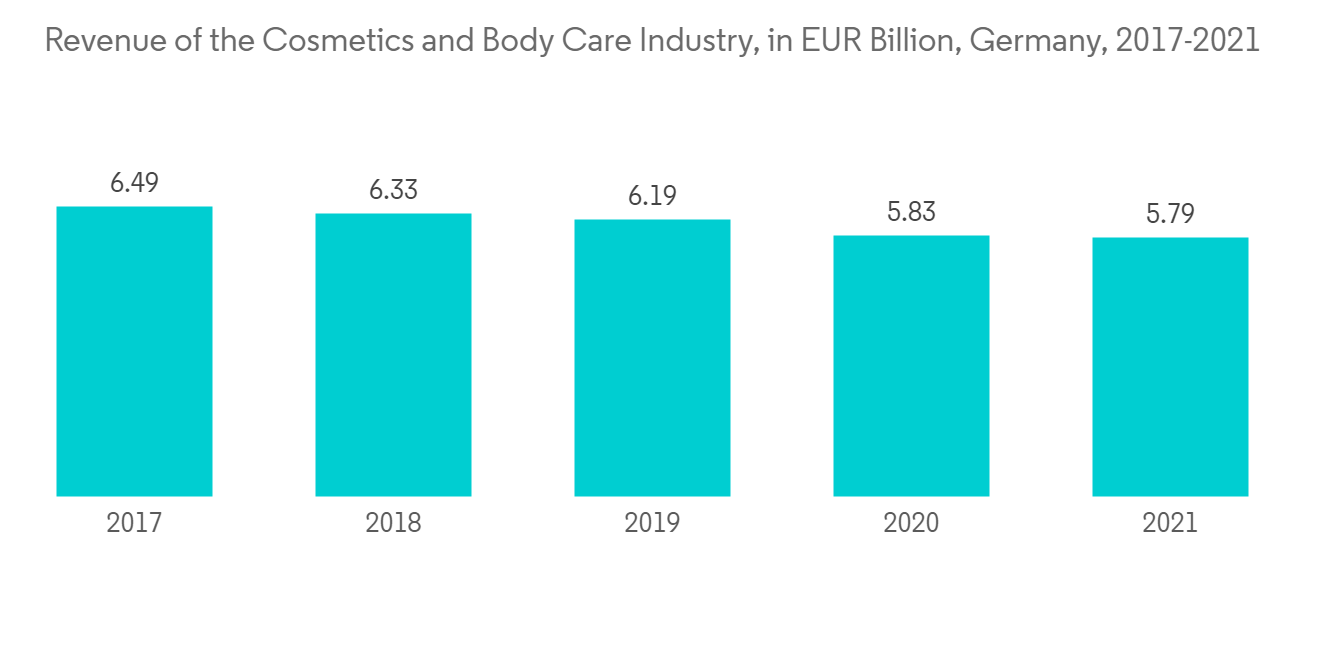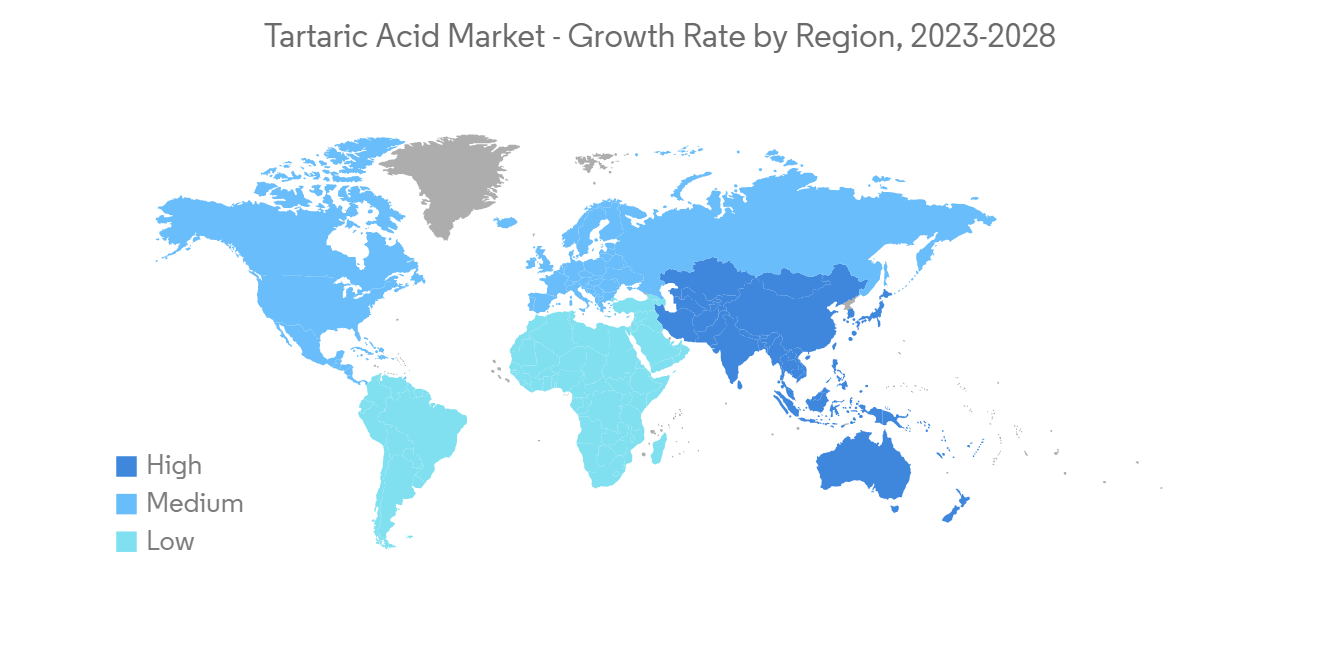 |
市場調査レポート
商品コード
1273487
酒石酸市場- 成長、動向、予測(2023年-2028年)Tartaric Acid Market - Growth, Trends, and Forecasts (2023 - 2028) |
||||||
● お客様のご希望に応じて、既存データの加工や未掲載情報(例:国別セグメント)の追加などの対応が可能です。 詳細はお問い合わせください。
| 酒石酸市場- 成長、動向、予測(2023年-2028年) |
|
出版日: 2023年04月14日
発行: Mordor Intelligence
ページ情報: 英文 120 Pages
納期: 2~3営業日
|
- 全表示
- 概要
- 目次
酒石酸の市場は予測期間中に5%以上のCAGRで推移すると予測されています。
COVID-19は様々な産業に影響を与え、2020年の酒石酸産業の成長に影響を与えました。しかし、パンデミック後の建設活動の急増は、業界全体の成長を促進しました。
主なハイライト
- 長期的には、医薬品および食品業界におけるマイクロカプセル化の採用が進み、医薬品業界からの需要が高まっていることが、市場成長の大きな要因となっています。
- 食品産業における合成酒石酸の使用を制限する政府規制の増加は、市場成長の妨げになると思われます。
- ニッチな用途での酒石酸の採用は、今後数年間、市場に機会をもたらすと思われます。
- アジア太平洋地域は酒石酸市場を独占し、予測期間中に最も高いCAGRで推移すると予想されます。
酒石酸の市場動向
化粧品業界からの需要増加
- 化粧品やパーソナルケア製品には、ボディケアやヘアケアなどさまざまな製品があります。シャンプー、ヘアコンディショナー、ボディソープ、石鹸などのスキンケア製品は、この分野で大きなシェアを占めています。
- 酒石酸とその塩は、化粧品やパーソナルケア製品のpH調整剤として使用されています。スキンケアの成分としては、リスクが低く、安全に使用できると考えられています。また、化粧品の製造において、酸化防止剤として使用されています。
- パーソナルケア分野は、エンドユーザー産業において3番目に大きな消費シェアを占めています。世界的に見ても、この分野は緩やかな成長率で推移しています。
- 男性用グルーミング製品市場は、男性消費者の間で個人の健康や外見に対する意識が高まっていることが成長の要因となっています。このような背景から、主要企業は男性向けの革新的な新製品を発売し、製品ラインアップと顧客基盤を拡大することに注力しています。その結果、競合他社よりも優位に立つことができるかもしれません。
- パーソナルケア協会であるCosmetic Europeによると、化粧品およびパーソナルケア産業は、少なくとも年間290億ユーロ(340億米ドル)の付加価値を欧州経済にもたらすとされています。ドイツは、欧州で最も大きな化粧品市場の一つです。2021年、ドイツのボディケア・化粧品業界は、ほぼ7億9,000万ユーロ(9億2,000万米ドル)の売上を計上しました。
- アジア太平洋地域は、世界の美容・パーソナルケア市場の40%以上を占めています。生産量は非常に高い水準に達し、そのため米国、カナダ、オーストリアなどの先進国に化粧品やパーソナルケア製品を輸出する中心的な拠点となっています。
- 中国は世界第2位の化粧品市場であり、世界最大の化粧品・スキンケア製品市場として台頭しています。メイクアップ、スキンケア、ヘアケア、個人衛生など様々な産業が含まれる中国の化粧品・スキンケア市場は、2021年から2022年にかけて成長を遂げました。さらに、人口の継続的な増加も、同国の化粧品需要を促進する要因となっています。さらに、人口の継続的な増加も、同国の化粧品需要を促進する要因となっています。
- 2022年、化粧品の小売販売額は3,936億人民元(610億米ドル)に達しました。中国の第二、第三の都市では化粧品の需要がさらに拡大しており、化粧品小売は今後数年間、成長の勢いを保つと予想されます。
- 酒石酸市場は、上記のすべての要因から、予測期間中に成長すると思われます。

アジア太平洋地域が市場を独占する
- 酒石酸市場では、アジア太平洋地域が最大のシェアを占めています。新興国市場の飲食品における酒石酸の消費量は、加工食品や飲食品の需要増に伴い、拡大すると予想されます。
- この地域の酒石酸の需要は、中国やインドなどの最大消費国の存在により大きく伸びています。また、医薬品業界における酒石酸の用途が急増していることも、市場成長を促進する重要な要因の一つとなっています。
- インドは、世界の医薬品分野で重要な位置を占めています。インドは世界最大のジェネリック医薬品の生産国です。インドの医薬品産業は、各種ワクチンの世界需要の50%以上、米国のジェネリック医薬品の40%、英国の全医薬品の25%を賄っています。
- さらに、日本の医薬品産業は、米国と中国をしのぐ世界最大級の規模を誇っています。日本における医療用医薬品の総生産額は、2021年に約9兆2,000億円(870億米ドル)となり、前年の約9兆3,000億円(880億米ドル)から減少しています。
- アジア太平洋地域は、世界の化粧品の約40%のシェアを含み、新興国でのパーソナルケアに対する意識の高まりとともに成長しており、化粧品およびパーソナルケア産業における最大の市場となっています。インドの10代から中高年の間で化粧品の消費が増加しており、主にセルフケアへの関心が高まっていることが要因となっています。
- 化粧品・パーソナルケア産業は、インドで最も急成長している消費財市場の一つであり、米国企業にとって市場参入の可能性が高いです。同国のパーソナルケアと化粧品部門は力強く成長し、小売店やブティックの棚面積を増やしました。
- インドでは、化粧品、石鹸、トイレタリー、エッセンシャルオイルの輸出額は、2022年に約29億米ドルに達しました。前年度と比べて大幅に増加しました。
- これらすべての要因が、予測期間中に同地域の酒石酸の市場を拡大させると予想されます。

酒石酸の産業概要
酒石酸市場は、その性質上、断片化されています。市場の主要企業には、Distillerie Mazzari S.p.A、AUSTRALIAN TARTARIC PRODUCTS、Anhui Hailan Biotechnology、The Tartaric Chemicals Corporation、Industria Chimica Valenzana I.C.V. SpAなど(順位は不同)がいます。
その他の特典:
- エクセル形式の市場予測(ME)シート
- 3ヶ月間のアナリストサポート
目次
第1章 イントロダクション
- 調査の前提条件
- 本調査の対象範囲
第2章 調査手法
第3章 エグゼクティブサマリー
第4章 市場力学
- 促進要因
- アジア太平洋地域および中南米地域におけるワイン需要の拡大
- 医薬品および食品業界におけるマイクロカプセル化の採用の増加
- 製薬業界からの需要増加
- 抑制要因
- 食品業界における合成酒石酸の使用制限に関する政府規制の強化
- 産業バリューチェーン分析
- ポーターのファイブフォース分析
- 供給企業の交渉力
- 消費者の交渉力
- 新規参入業者の脅威
- 代替品の脅威
- 競合の度合い
第5章 市場セグメンテーション
- 種類
- 天然酒石酸
- 合成酒石酸
- 用途
- 防腐剤・添加剤
- 緩下剤
- 中間体
- その他の用途
- エンドユーザー産業
- 飲食品
- 医薬品
- 化粧品
- 建設業
- その他エンドユーザー産業
- 地域
- アジア太平洋地域
- 中国
- インド
- 日本
- 韓国
- その他アジア太平洋地域
- 北米
- 米国
- カナダ
- メキシコ
- 欧州
- ドイツ
- 英国
- フランス
- イタリア
- スペイン
- その他欧州
- 南米
- ブラジル
- アルゼンチン
- その他南米
- 中東およびアフリカ
- サウジアラビア
- 南アフリカ
- その他中東とアフリカ
- アジア太平洋地域
第6章 競合情勢
- M&A、ジョイントベンチャー、コラボレーション、契約など
- 市場シェア(%)/ランキング分析
- 主要企業が採用した戦略
- 企業プロファイル
- ATP Group
- Anhui Hailan Bio-technology Co., ltd
- AUSTRALIAN TARTARIC PRODUCTS
- Changmao Biochemical Engineering Company Limited
- Dastech International Inc.
- Derivados Vinicos S.A.
- Distillerie Mazzari S.p.A
- Giovanni Randi SpA
- Industria Chimica Valenzana I.C.V. SpA
- Ningbo Jinzhan Biotechnology Co.,Ltd.
- Omkar Speciality Chemicals Ltd
- Tarac Technologies
- Tartaros Gonzalo Castello
- The Tartaric Chemicals Corporation
- Vinicas
第7章 市場機会および将来動向
- 酒石酸のニッチアプリケーションへの採用
- その他のビジネスチャンス
The market for tartaric acid is projected to register a CAGR of more than 5% during the forecast period.
COVID-19 impacted various industries, affecting the tartaric acid industry growth in 2020. However, the surging construction activities post-pandemic propelled the overall industry growth.
Key Highlights
- Over the long term, the significant factors driving the studied market growth are increased microencapsulation adoption across pharmaceuticals and food industries and rising demand from the pharmaceutical industry.
- Increasing government regulations for restricting synthetic tartaric acid use in the food industry will likely hinder the market growth.
- Adopting tartaric acid in niche applications will likely create opportunities for the market in the coming years.
- The Asia-Pacific region is expected to dominate the tartaric acid market and will likely witness the highest CAGR during the forecast period.
Tartaric Acid Market Trends
Increasing Demand from the Cosmetics Industry
- Cosmetics and personal care products include a variety of body care, as well as hair care products. Shampoos, hair conditioners, body washes, soaps, and other skincare products, occupy a significant share of the segment.
- Tartaric acid and its salts are used as pH adjusters in cosmetics and personal care products. It is considered a low-risk and safe-to-use ingredient for skincare. It is also used as an antioxidant in the production of cosmetics.
- The personal care segment accounts for the third-largest consumption share in end-user industries. Globally, this segment is growing at a moderate rate.
- An increasing consciousness catalyzed the male grooming products market growth among male consumers of personal wellness and appearance. Owing to this factor, key players are focusing on launching new and innovative products for men to increase their product offerings and customer base. It may give them an edge over their competitors.
- According to Cosmetic Europe, the personal care association, the cosmetics and personal care industry brings at least EUR 29 billion (USD 34 billion) in added value to the European economy annually. Germany is one of the biggest cosmetics markets in Europe. In 2021, the German body care and cosmetics industry generated almost EUR 790 million (USD 920 million) in revenue.
- The Asia-Pacific region accounts for over 40% of the global beauty and personal care marketplace. The production reached very high levels, thus becoming a central hub for exporting cosmetics and personal care products to developed nations, such as the United States, Canada, and Austria.
- China is the world's second-largest cosmetics market and emerging as the largest market in cosmetics and skin care products globally. The Chinese cosmetics and skin care market, which includes various industries such as makeup, skincare, hair care, and personal hygiene, experienced growth in 2021-2022. Furthermore, the continuous population growth is another factor fueling the demand for cosmetics products in the country. It, in turn, is augmenting the growth of the market studied.
- In 2022, the retail sales value of cosmetic products reached CNY 393.6 billion (USD 61 billion). As the demand for cosmetic products expands further in second-and third-tier cities of China, cosmetics retail is expected to maintain its growth momentum in the coming years.
- The tartaric acid market will likely grow during the forecast period due to all the factors above.

Asia-Pacific Region to Dominate the Market
- Asia-Pacific region accounted for the largest share of the tartaric acid market. Tartaric acid consumption in foods and beverages in developing markets is expected to grow, along with the increasing demand for processed food and beverages.
- The demand for tartaric acid in the region is growing significantly due to the presence of the largest consuming countries, such as China and India. The surging application of tartaric acid in the pharmaceutical industry is also one of the key factors driving the market growth.
- India holds a significant position in the global pharmaceuticals sector. India is the largest producer of generic drugs in the world. The Indian pharmaceutical industry caters to more than 50% of the global demand for various vaccines, 40% of generic medicine in the United States, and 25% of all medicines in the United Kingdom.
- Furthermore, the pharmaceutical industry in Japan is one of the largest in the world, surpassed only by the United States and China. The total production value of medical drugs in Japan amounted to approximately JPY 9.2 trillion (USD 87 billion) in 2021, a decrease from around JPY 9.3 trillion (USD 88 billion) in the previous year.
- The Asia-Pacific region includes a share of nearly 40% in the global cosmetics and growing with the increase in the awareness of personal care in the emerging economies, making it the largest market in the cosmetics and personal care industries. Cosmetics consumption is increasing among Indian teens and middle-aged people, primarily driven by an increasing focus on self-care.
- The cosmetics and personal care industry is one of India's fastest-growing consumer product markets, with a strong market entry potential for US companies. The country's personal care and cosmetics sector grew strongly, increasing shelf space in retail stores and boutiques.
- In India, the export value of cosmetics, soap, toiletries, and essential oils amounted to nearly USD 2.9 billion in 2022. It was a significant increase compared to the previous fiscal year.
- All these factors are expected to increase the market for tartaric acid in the region during the forecast period.

Tartaric Acid Industry Overview
The tartaric acid market is fragmented in nature. Some of the major players in the market include Distillerie Mazzari S.p.A, AUSTRALIAN TARTARIC PRODUCTS, Anhui Hailan Biotechnology Co. Ltd, The Tartaric Chemicals Corporation, and Industria Chimica Valenzana I.C.V. SpA, among others (not in any particular order).
Additional Benefits:
- The market estimate (ME) sheet in Excel format
- 3 months of analyst support
TABLE OF CONTENTS
1 INTRODUCTION
- 1.1 Study Assumptions
- 1.2 Scope of the Study
2 RESEARCH METHODOLOGY
3 EXECUTIVE SUMMARY
4 MARKET DYNAMICS
- 4.1 Drivers
- 4.1.1 Growing Demand for Wine in the Asia-Pacific and Latin American Regions
- 4.1.2 Increased Adoption of Microencapsulation across Pharmaceuticals and Food Industries
- 4.1.3 Rising Demand from the Pharmaceutical Industry
- 4.2 Restraints
- 4.2.1 Increasing Government Regulations for Restricted Use of Synthetic Tartaric Acid in the Food Industry
- 4.3 Industry Value-Chain Analysis
- 4.4 Porter's Five Forces Analysis
- 4.4.1 Bargaining Power of Suppliers
- 4.4.2 Bargaining Power of Consumers
- 4.4.3 Threat of New Entrants
- 4.4.4 Threat of Substitute Products and Services
- 4.4.5 Degree of Competition
5 MARKET SEGMENTATION (Market Size in Volume)
- 5.1 Type
- 5.1.1 Natural Tartaric Acid
- 5.1.2 Synthetic Tartaric Acid
- 5.2 Application
- 5.2.1 Preservative and Additive
- 5.2.2 Laxative
- 5.2.3 Intermediate
- 5.2.4 Other Applications
- 5.3 End-user Industry
- 5.3.1 Food and Beverage
- 5.3.2 Pharmaceutical
- 5.3.3 Cosmetics
- 5.3.4 Construction
- 5.3.5 Other End-user Industries
- 5.4 Geography
- 5.4.1 Asia-Pacific
- 5.4.1.1 China
- 5.4.1.2 India
- 5.4.1.3 Japan
- 5.4.1.4 South Korea
- 5.4.1.5 Rest of Asia-Pacific
- 5.4.2 North America
- 5.4.2.1 United States
- 5.4.2.2 Canada
- 5.4.2.3 Mexico
- 5.4.3 Europe
- 5.4.3.1 Germany
- 5.4.3.2 United Kingdom
- 5.4.3.3 France
- 5.4.3.4 Italy
- 5.4.3.5 Spain
- 5.4.3.6 Rest of Europe
- 5.4.4 South America
- 5.4.4.1 Brazil
- 5.4.4.2 Argentina
- 5.4.4.3 Rest of South America
- 5.4.5 Middle-East and Africa
- 5.4.5.1 Saudi Arabia
- 5.4.5.2 South Africa
- 5.4.5.3 Rest of Middle-East and Africa
- 5.4.1 Asia-Pacific
6 COMPETITIVE LANDSCAPE
- 6.1 Mergers and Acquisitions, Joint Ventures, Collaborations, and Agreements
- 6.2 Market Share (%)**/Ranking Analysis
- 6.3 Strategies Adopted by Leading Players
- 6.4 Company Profiles
- 6.4.1 ATP Group
- 6.4.2 Anhui Hailan Bio-technology Co., ltd
- 6.4.3 AUSTRALIAN TARTARIC PRODUCTS
- 6.4.4 Changmao Biochemical Engineering Company Limited
- 6.4.5 Dastech International Inc.
- 6.4.6 Derivados Vinicos S.A.
- 6.4.7 Distillerie Mazzari S.p.A
- 6.4.8 Giovanni Randi SpA
- 6.4.9 Industria Chimica Valenzana I.C.V. SpA
- 6.4.10 Ningbo Jinzhan Biotechnology Co.,Ltd.
- 6.4.11 Omkar Speciality Chemicals Ltd
- 6.4.12 Tarac Technologies
- 6.4.13 Tartaros Gonzalo Castello
- 6.4.14 The Tartaric Chemicals Corporation
- 6.4.15 Vinicas
7 MARKET OPPORTUNITIES AND FUTURE TRENDS
- 7.1 Adoption of Tartaric Acid in Niche Application
- 7.2 Other Opportunities
